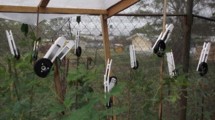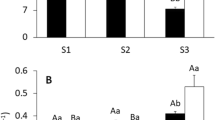Abstract
Key message
Acacia senegal and Acacia seyal present different drought stress coping mechanisms that are independent of substrate fertility. Higher substrate fertility increased aboveground plant growth, even with low watering.
Abstract
The potential of native African tree species for agriculture and forestry have not yet been thoroughly investigated. In this experiment, we studied the early growth of Acacia senegal and Acacia seyal plants in an experiment with two substrates of contrasting fertility (low/high) and two watering frequency regimes (low = 24.40 l/m2 per month, high = 48.80 l/m2 per month). Our objectives were: (1) to study whether the mechanisms by which nutrients affect plant growth at the seedling stage operate differently when water availability varies, and (2) to look for differences in the growth strategies of the two species in early stages. Higher substrate fertility increased aboveground plant growth at the expense of roots in both water regimes. Though water stress significantly limited growth under both soil conditions, substrate fertility effects were relatively higher in plants with low water supply than in those with high water supply. However, even with low resources the root-to-shoot ratio was between 0.7 and 0.9, plants presented adequate nutrition and no mortality was observed. This indicates opportunistic mechanisms for water and nutrient use. A. seyal showed the lowest negative pre-dawn stem water potential value (−0.15 MPa) and shed nearly all leaves in the hottest month of the assay, which suggests a different drought avoidance strategy and adaptation to water stress than A. senegal. Both species can be produced successfully in local nursery conditions and can survive and thrive with low watering. The study also demonstrated that fast growing genotypes can be effectively isolated in nursery conditions.
Similar content being viewed by others
References
Aref IM, El-Juhany L, Hegazy SS (2003) Comparison of the growth and biomass production of six Acacia species in Riyadh, Saudi Arabia after 4 years of irrigated cultivation. J Arid Environ 54:783–792
Argaw M, Teketay D, Olsson M (1999) Soil seed flora, germination and regeneration pattern of woody species in an Acacia woodland of the Rift Valley in Ethiopia. J Arid Environ 43:411–435
Bowie M, Ward D (2004) Water and nutrient status of the mistletoe Plicosepalus acaciae parasitic on isolated Negev Desert populations of Acacia raddiana differing in level of mortality. J Arid Environ 56:487–508
Brady N, Well R (2002) The Nature and Properties of Soils. Prentice Hall, New Jersey
Chapin F (1991) System of physiological responses. Bioscience 41:29–36
Cheung WH, Senay GB, Singh A (2008) Trends and spatial distribution of annual and seasonal rainfall in Ethiopia. Int J Climatol 28:1723–1734
Gaafar A, Salih A, Luukkanen O, El Fadl MA, Kaarakka V (2006) Improving the traditional Acacia senegal-crop system in Sudan: the effect of tree density on water use, gum production and crop yields. Agrofor Syst 66:1–11
Gebrekirstos A, Teketay D, Fetene M, Mitlöhner R (2006) Adaptation of five co-occurring tree and shrub species to water stress and its implication in restoration of degraded lands. For Ecol Manage 229:259–267
Gebrekirstos A, Mitlöhner R, Teketay D, Worbes M (2008) Climate–growth relationships of the dominant tree species from semi-arid savanna woodland in Ethiopia. Trees Struct Funct 22:631–641
Gray A, Odee D, Cavers S et al (2013) Does geographic origin dictate ecological strategies in Acacia senegal (L.) Willd.? Evidence from carbon and nitrogen stable isotopes. Plant Soil 369:479–496
Harrier LA, Whitty P, Sutherlnd JM, Sprent JI (2000) Pre-infection events in non-nodulating species of African Acacia. Afr J Ecol 38:8–15
Hooper DU, Johnson L (1999) Nitrogen limitation in dryland ecosystems: responses to geographical and temporal variation in precipitation. Biogeochemistry 46:247–293
Larwanou M, Ræbild A, Issa R, Kjær ED (2010) Performance of Acacia Senegal (L.) willd provenances in dryland savannah of Niger. Silvae Genet 5:210–218
Li F, Bao W, Wu N, You C (2008) Growth, biomass partitioning, and water-use efficiency of a leguminous shrub (Bauhinia faberi var. microphylla) in response to various water availabilities. New For 36:53–65
Midgley JJ, Bond WJ (2001) A synthesis of the demography of African acacias. J Trop Ecol 17:871–886
Nicolini G, Tarchiani V, Saurer M, Cherubini P (2010) Wood-growth zones in Acacia seyal Delile in the Keita Valley, Niger: is there any climatic signal? J Arid Environ 74:355–359
Oba G, Nordal I, Stenseth NC, Stave J, Bjorå C, Muthondeki JK, Bii WKA (2001) Growth performance of exotic and indigenous tree species in saline soils in Turkana, Kenya. J Arid Environ 47:499–511
Ogbonnaya C, Nwalozie M, Roy-Macauley H, Annerose D (1998) Growth and water relations of Kenaf (Hibiscus cannabinus L.) under water deficit on a sandy soil. Ind Crops Prod 8:65–76
Otieno D, Schmidt M, Adiku S, Tenhunen J (2005) Physiological and morphological responses to water stress in two Acacia species from contrasting habitats. Tree Physiol 25:361–371
Palmberg C (1981) A vital fuelwood gene pool is in danger. Unasylva (FAO) 133:33
Raddad EAY (2007) Ecophysiological and genetic variation in seedling traits and in first-year field performance of eight Acacia senegal provenances in the Blue Nile, Sudan. New For 34:207–222
Raddad EAY, Luukkanen O (2006) Adaptive genetic variation in water-use efficiency and gum yield in Acacia senegal provenances grown on clay soil in the Blue Nile region, Sudan. For Ecol Manage 226:219–229
Raddad EAY, Salih AA, El Fadl MA et al (2005) Symbiotic nitrogen fixation in eight Acacia senegal provenances in dryland clays of the Blue Nile Sudan estimated by the 15N natural abundance method. Plant Soil 275:261–269
Raddad EY, Luukkanen O, Salih AA, Kaarakka V, Elfadl MA (2006) Productivity and nutrient cycling in young Acacia senegal farming systems on Vertisol in the Blue Nile region, Sudan. Agrofor Syst 68:193–207
Reuter D, Robinson J (1997) Plant Analysis: an interpretation manual. CSIRO Publishing, Australia
Sánchez-Bayo F, King G (1994) Ecological factors affecting the early development of seedlings of three Acacia species from Ethiopia. South Afr J Plant Soil 11:147–149
SAS (2012) SAS Institute Inc. User’s Guide. SAS/STAT®, Cary
Seleshi Y, Zanke U (2004) Recent changes in rainfall and rainy days in Ethiopia. Int J Climatol 24:973–983
Singh B, Singh G (2006) Effects of controlled irrigation on water potential, nitrogen uptake and biomass production in Dalbergia sissoo seedlings. Environ Exp Bot 55:209–219
Snyman HA (2002) Short-term response of rangeland botanical composition and productivity to fertilization (N and P) in a semi-arid climate of South Africa. J Arid Environ 50:167–183
Song CJ, Ma KM, Qu LY, Liu Y, Xu XL, Fu BJ, Zhong JF (2010) Interactive effects of water, nitrogen and phosphorus on the growth, biomass partitioning and water-use efficiency of Bauhinia faberi seedlings. J Arid Environ 74:1003–1012
Sprent JI, Odee DW, Dakora FD (2010) African legumes: a vital but under-utilized resource. J Exp Bot 61:1257–1265
StatSoft (2002) Statsoft Inc. Statistica For Windows. StatSoft, Tulsa
Tan W, Hogan G (1997) Physiological and morphological responses to nitrogen limitation in jack pine seedlings: potential implications for drought tolerance. New For 14:19–31
Traoré S, Zerbo L, Schmidt M, Thiombiano L (2012) Acacia communities and species responses to soil and climate gradients in the Sudano-Sahelian zone of West Africa. J Arid Environ 87:144–152
Walter H (1997) Zonas de Vegetación y Clima. Omega, Barcelona
Wilson TB, Witkowski ETF (1998) Water requirements for germination and early seedling establishment in four African savanna woody plant species. J Arid Environ 38:541–550
Wu F, Bao W, Li F, Wu N (2008) Effects of drought stress and N supply on the growth, biomass partitioning and water-use efficiency of Sophora davidii seedlings. Environ Exp Bot 63:248–255
Zainudin S, Awang K, Hanif A (2003) Effects of combined nutrient and water stress on the growth of Hopea odorata Roxb. and Mimusops elengi Linn. seedlings. J Arboric 29:79–83
Zida D, Tigabu M, Sawadogo L, Odén PC (2008) Initial seedling morphological characteristics and field performance of two Sudanian savanna species in relation to nursery production period and watering regimes. For Ecol Manage 255:2151–2162
Author contribution statement
FB conceived the experiment; AK, ERG, RA, VP and FB designed the experiment. AK performed the experiment. AK and ERG analyzed the data. AK wrote the initial draft of the manuscript. AK, ERG, RA, VP and FB revised the drafts and final manuscript. The authors declare that they have no conflict of interest.
Acknowledgments
We are grateful to editors and two anonymous referees for their valuable comments on the initial manuscript. We wish to thank AECID and INIA for the research grant awarded to A. Kassa; J.M. del Arco for assistance with the water potential measurements; C. Herrero and B. Turrión for assistance with nutrient analyses. Our thanks to W. Tadesse for facilitating all the information relevant to the Ethiopian forest, and to the University of Valladolid staff for their assistance in the greenhouse.
Author information
Authors and Affiliations
Corresponding author
Additional information
Communicated by C. Lovelook.
Electronic supplementary material
Below is the link to the electronic supplementary material.
Rights and permissions
About this article
Cite this article
Merine, A.K., Rodríguez-García, E., Alía, R. et al. Effects of water stress and substrate fertility on the early growth of Acacia senegal and Acacia seyal from Ethiopian Savanna woodlands. Trees 29, 593–604 (2015). https://doi.org/10.1007/s00468-014-1138-3
Received:
Revised:
Accepted:
Published:
Issue Date:
DOI: https://doi.org/10.1007/s00468-014-1138-3




